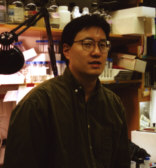William Sha

Professor Emeritus of Immunology and Molecular Medicine
Research Interests
We are interested in understanding the molecular control of antibody responses by B cells. We previously identified a novel costimulatory molecule, B7h, expressed on B cells and other antigen-presenting cells that is the sole in vivo ligand for the ICOS costimulatory receptor expressed on activated T cells. B7h is highly regulated and appears to be a critical control point on B cells for controlling the magnitude of antibody responses. We have identified two potent mechanisms, ectodomain shedding and transcriptional regulation, that severely limit B7h expression on activated B cells. We are currently studying how these molecular mechanisms are regulated and control antibody responses using both in vitro tissue culture assays and transgenic/knockout mouse models.
Current Projects
Control of B7h shedding by Toll-like receptors (TLRs). TLRs are innate pattern recognition receptors that are critical for identifying infectious agents and shaping the correct adaptive immune responses of B cells and T cells. We recently found that CpG DNA, the ligand for TLR9, potently inhibits ectodomain shedding of B7h on B cells. These results indicate that B7h can exist in vivo in two distinct states: a labile form whose ability to signal ICOS is quickly terminated by shedding and a shedding-resistant form induced by TLR9 with sustained ability to signal ICOS on activated T cells. We are investigating the molecular mechanisms by which TLR7/8 and TLR9 ligands inhibit shedding of B7h on B cells by identifying both the protease(s) responsible for B7h shedding and the signaling components that are involved. We are also examining whether similar regulation of B7h by TLR ligands occurs on dendritic cells that regulate differentiation of T cells.Is control of B7h expression a B cell-extrinsic mechanism involved in autoimmunity? Both TLR9/CpG DNA and ICOS/B7h receptor/ligand signaling pathways are critical in the development of autoimmune antibodies that cause diseases like rheumatoid arthritis and lupus. While CpG DNA is known to cause direct cell-intrinsic activation of B cells, it is not known how cell-extrinsic activation of T cells by B cells, that is required for the development of autoimmune disease, is triggered CpG DNA. We are using transgenic and knockout mouse models to examine whether stabilization of B7h by TLR9 is an important molecular mechanism by which CpG DNA initiates autoimmune antibody production.
Functional retroviral screens for host defense genes. Retroviral vectors provide a rapid and effective means to examine the function of different gene products in immune cells. We have adapted this approach to study host-pathogen interactions using Toxoplasma gondii, an obligate intracellular parasite that is a significant infectious agent in immunocompromised patients. Within host cells, Toxoplasma gondii parasites reside within a highly specialized parasitophorous vacuole, and can interconvert between a rapidly dividing tachyzoite state and a dormant bradyzoite state. We are conducting screens with retroviral cDNA libraries to functionally identify host defense genes that regulate both growth and conversion of Toxoplasma gondii within host cells.
Selected Publications
ICOS-induced B7h shedding on B cells is inhibited by TLR7/8 and TLR9. [E.C. Logue, S. Bakkour, M.M. Murphy, H. Nolla, and W.C. Sha (2006) Journal of Immunology 177, 2356-64]CD28-B7 bidirectional signaling: a two-way street to activation. [E.C. Logue and W.C. Sha (2004) Nat Immunol. 5, 1103-5]
Identification of gene function by cyclical packaging rescue of retroviral cDNA libraries. [D. Bhattacharya, E.C. Logue, S. Bakkour, J. DeGregori, and W.C. Sha (2002) Proceedings Natl. Acad. Sciences 99, 8838-43]
Constitutive expression of the B7h ligand for inducible costimulator on naive B cells is extinguished after activation by distinct B cell receptor and interleukin 4 receptor-mediated pathways and can be rescued by CD40 signaling [L. Liang, E.M. Porter, and W.C. Sha (2002) Journal of Exp. Med. 196, 97-108]
The right place at the right time: novel B7 family members regulate effector T cell responses. [L. Liang and W.C. Sha (2002) Curr. Opinion Immunology 14, 384-390]
Enhancement of CD8+ T-cell responses by ICOS/B7h costimulation. [J.J. Wallin, L. Liang, A. Bakardjiev, and W.C. Sha (2001) Journal of Immunology 167, 132-139]
B7h, a novel costimulatory homologue of B7.1 and B7.2, is induced by TNFa. [M.M. Swallow, J.J. Wallin, and W.C. Sha (1999) Immunity 11, 423-432]
Last Updated 2006-08-23